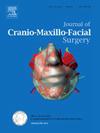The cleft palate-associated gene Midline1 plays a role in mouse palatal development by regulating MMP8 and Snail proteins
IF 2.1
2区 医学
Q2 DENTISTRY, ORAL SURGERY & MEDICINE
引用次数: 0
Abstract
Objective
This study aimed to investigate the role of the Midline1 gene in secondary palate development by analyzing its expression and function in palatal shelf fusion and morphology.
Design
Initially, twenty mouse embryos were collected for each of the embryonic stages E13.5, E13.75, and E14.5. Whole-mount in situ hybridization was performed approximately ten times to optimize the experimental protocol and to analyze the expression pattern of Midline1 (MID1) in the palatal tissues at these developmental stages. Subsequently, palatal tissues from E13.5 embryos were treated with varying concentrations of Midline1 small interfering RNA (MID1 siRNA), and the knockdown efficiency was evaluated using Reverse Transcription Quantitative Polymerase Chain Reaction (RT-qPCR), with each concentration tested in triplicate. Based on the results, the most effective concentration, 100 nM MID1 siRNA, was selected for further experiments. Subsequently, twelve E13.5 palatal explants were allocated into two groups: six explants were treated with 100 nM MID1 siRNA (experimental group), and six with scrambled small interfering RNA(Scramble siRNA; control group). After 48 h of in vitro culture, hematoxylin and eosin (HE) staining was performed to evaluate the morphology of palatal shelf fusion. To evaluate apoptotic activity, Terminal deoxynucleotidyl transferase dUTP Nick-End Labeling (TUNEL) staining was performed on both experimental and control groups. Finally, immunohistochemistry and Western blot analyses were conducted to examine the expression levels of Matrix Metalloproteinase 8 (MMP8) and Snail Family Transcription Factors (Snail) proteins in three biological replicates from each group.
Results
Midline1 deficiency resulted in incomplete palatal shelf fusion and significantly reduced apoptosis. Additionally, the knockdown of Midline1 led to the upregulation of Snail and MMP8 gene expression, indicating that Midline1 plays a critical role in regulating epithelial-to-mesenchymal transition and maintaining cytoskeletal stability during palate development.
Conclusions
Midline1 is essential for normal secondary palate development. Its dysregulation disrupts palatal shelf fusion and morphology, potentially contributing to craniofacial abnormalities such as cleft palate. These findings provide new insights into the molecular mechanisms underlying palate development and suggest that Midline1 could be a therapeutic target for addressing cleft palate and related defects.
腭裂相关基因Midline1通过调控MMP8和Snail蛋白在小鼠腭发育中起作用。
目的:通过分析Midline1基因在腭壁融合及形态中的表达和功能,探讨Midline1基因在腭壁发育中的作用。设计:最初,收集E13.5、E13.75和E14.5胚胎期各20只小鼠胚胎。为了优化实验方案并分析Midline1 (MID1)在这些发育阶段腭组织中的表达模式,我们进行了大约10次的全载原位杂交。随后,用不同浓度的Midline1小干扰RNA (MID1 siRNA)处理E13.5胚胎的腭组织,并使用逆转录定量聚合酶链反应(RT-qPCR)评估敲低效率,每种浓度都进行三次测试。根据实验结果,选择最有效浓度为100 nM的MID1 siRNA进行进一步实验。随后,将12个E13.5腭外植体分为两组:6个外植体用100 nM的MID1 siRNA处理(实验组),6个外植体用乱序小干扰RNA(Scramble siRNA;对照组)。体外培养48 h后,采用苏木精和伊红(HE)染色评价腭架融合形态。为了评估凋亡活性,对实验组和对照组进行末端脱氧核苷酸转移酶dUTP镍端标记(TUNEL)染色。最后,采用免疫组织化学和Western blot方法检测基质金属蛋白酶8 (MMP8)和蜗牛家族转录因子(Snail Family Transcription Factors, Snail)蛋白在每组3个生物重复中的表达水平。结果:Midline1缺失导致腭架融合不完全,细胞凋亡明显减少。此外,Midline1的敲低导致Snail和MMP8基因表达上调,这表明Midline1在腭发育过程中调节上皮向间质转化和维持细胞骨架稳定性方面起着关键作用。结论:中线1对正常的次腭发育至关重要。它的失调破坏了腭架融合和形态,可能导致颅面异常,如腭裂。这些发现为腭裂发育的分子机制提供了新的见解,并提示Midline1可能成为腭裂及相关缺陷的治疗靶点。
本文章由计算机程序翻译,如有差异,请以英文原文为准。
求助全文
约1分钟内获得全文
求助全文
来源期刊
CiteScore
5.20
自引率
22.60%
发文量
117
审稿时长
70 days
期刊介绍:
The Journal of Cranio-Maxillofacial Surgery publishes articles covering all aspects of surgery of the head, face and jaw. Specific topics covered recently have included:
• Distraction osteogenesis
• Synthetic bone substitutes
• Fibroblast growth factors
• Fetal wound healing
• Skull base surgery
• Computer-assisted surgery
• Vascularized bone grafts

 求助内容:
求助内容: 应助结果提醒方式:
应助结果提醒方式:


